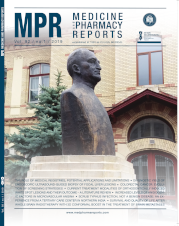Prolactinoma in males: a single center experience in Northern Africa
DOI:
https://doi.org/10.15386/mpr-2888Keywords:
prolactinoma, prolactin, testosterone, hypogonadism, visual impairment, dopaminergic agonist, pituitary surgeryAbstract
Background and aims. Male prolactinoma remains a singular entity. Our study represents the first reported experience of male prolactinoma in Northern Africa. Our work aimed to characterize prolactinomas in the male population, an entity known for its aggressive features, and also to highlight the specific challenges encountered in a North African clinical context.
Methods. This is a retrospective descriptive study of male patients presenting with prolactinoma at the endocrinology, diabetology and nutrition department of a university hospital center over a 10-year period.
Results. The mean age at diagnosis was 37 ± 11 years. Mass effect related symptoms were present in 83% of cases. Decreased visual acuity was found in 60% of cases. Galactorrhea was found in 13% of cases, decreased libido in 60% of cases, and gynecomastia in 20% of cases. At the time of diagnosis, the mean prolactin level was 4,685 ng/ml (79-33,000). All patients had hypogonadotropic hypogonadism. Among our patients, 66% had undergone dopaminergic agonists as monotherapy, and pituitary surgery was performed in 33% of cases in conjunction with dopaminergic agonists. After a 30-month average follow-up, medical treatment achieved prolactin control in 83% of cases and tumor shrinkage in 70%, while surgery achieved prolactin control in 85% and tumor shrinkage in 70% of cases.
Conclusion. Prolactinoma in men is usually invasive and of considerable volume, putting patients at risk of mass effect related symptoms, especially ophthalmologic complications. Hence the importance of early, multidisciplinary and personalized management.
Downloads
Published
How to Cite
Issue
Section
License
Copyright (c) 2025 Nada El Yamani, Anouar Jamal, Nissrine Bouichrat, Siham Rouf, Hanane Latrech
The authors are required to transfer the copyright of the published paper to the journal. This is done by agreeing to sign the Copyright Assignment Form. Whenever the case, authors are also required to send permissions to reproduce material (such as illustrations) from the copyright holder.

The papers published in the journal are licensed under a Creative Commons Attribution-NonCommercial-NoDerivatives 4.0 International License.

